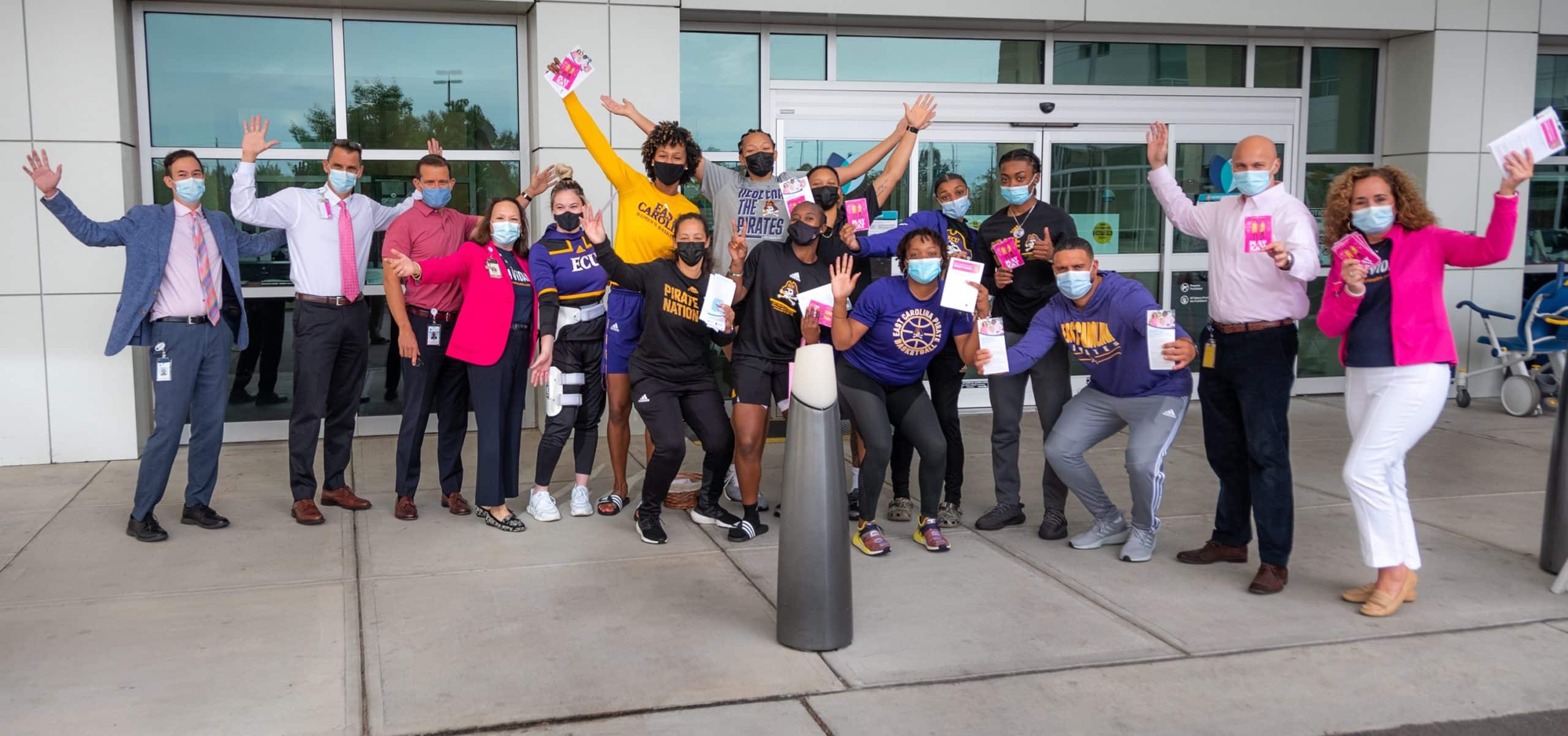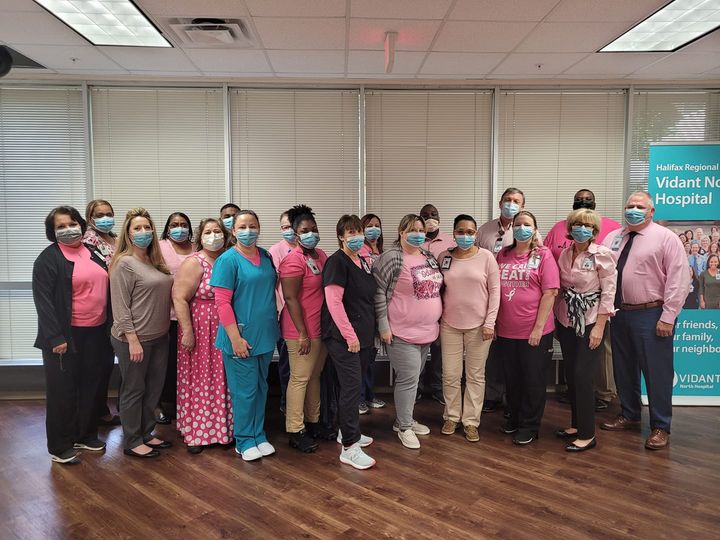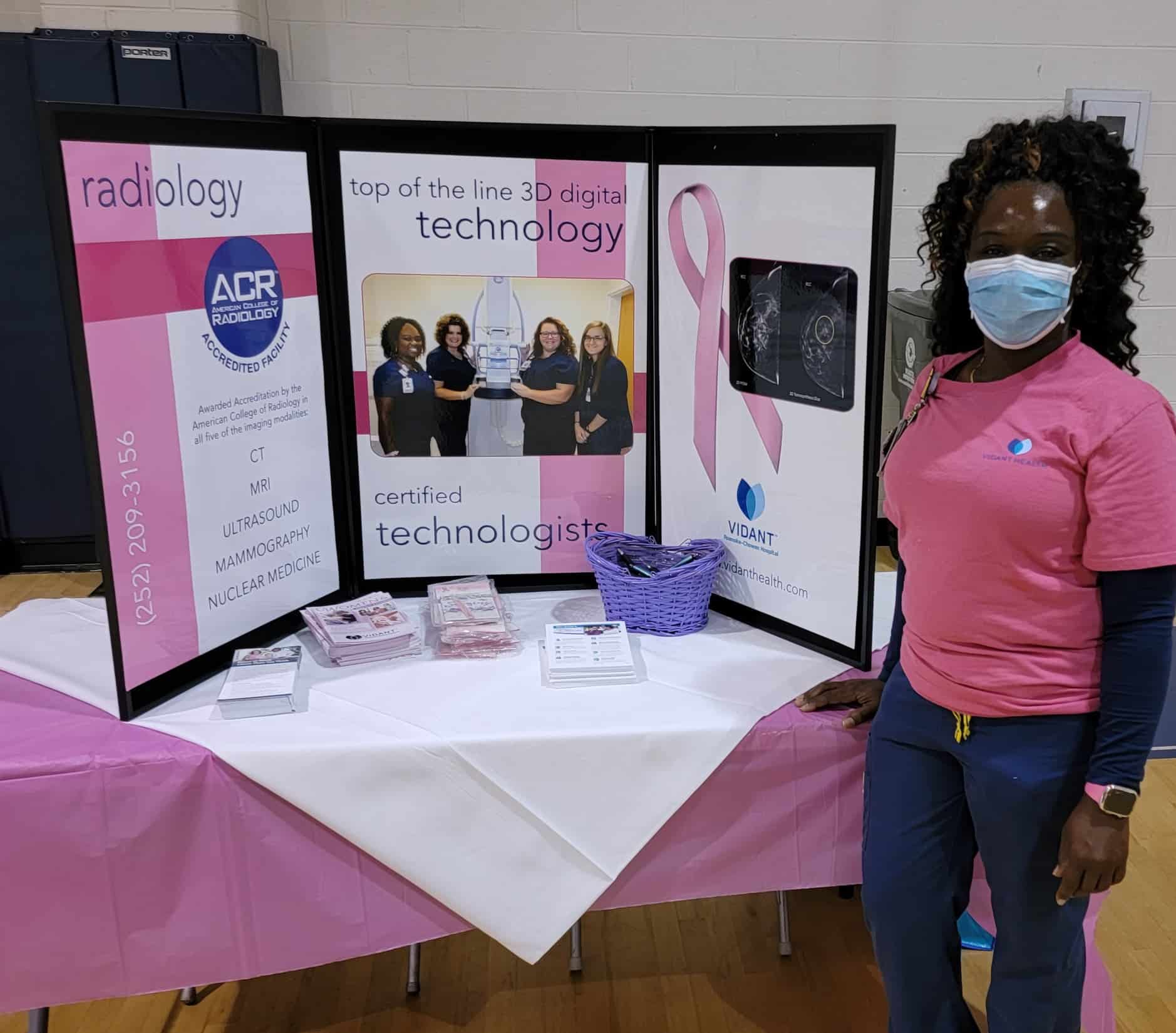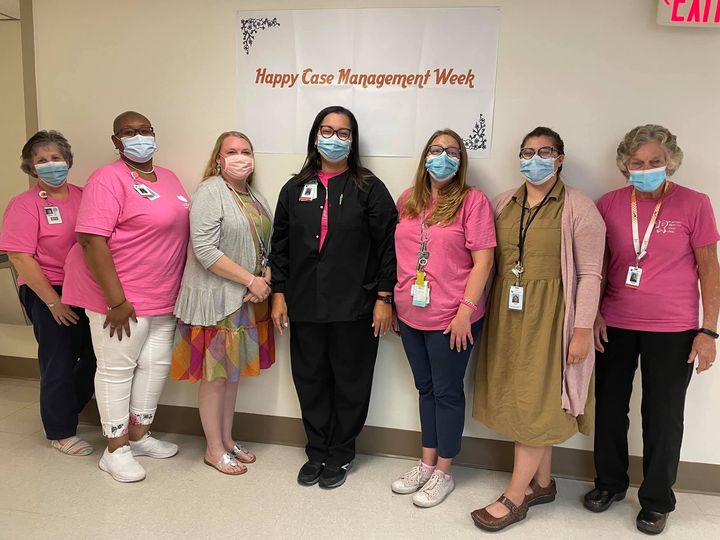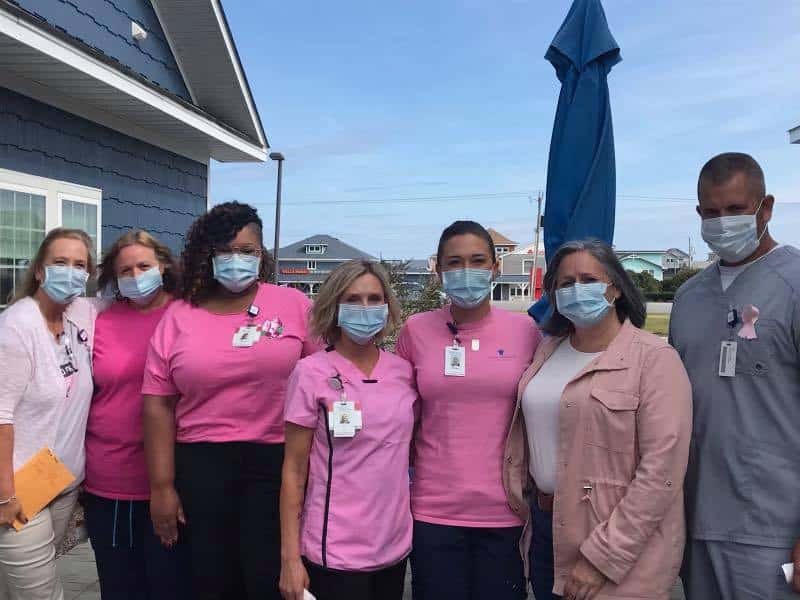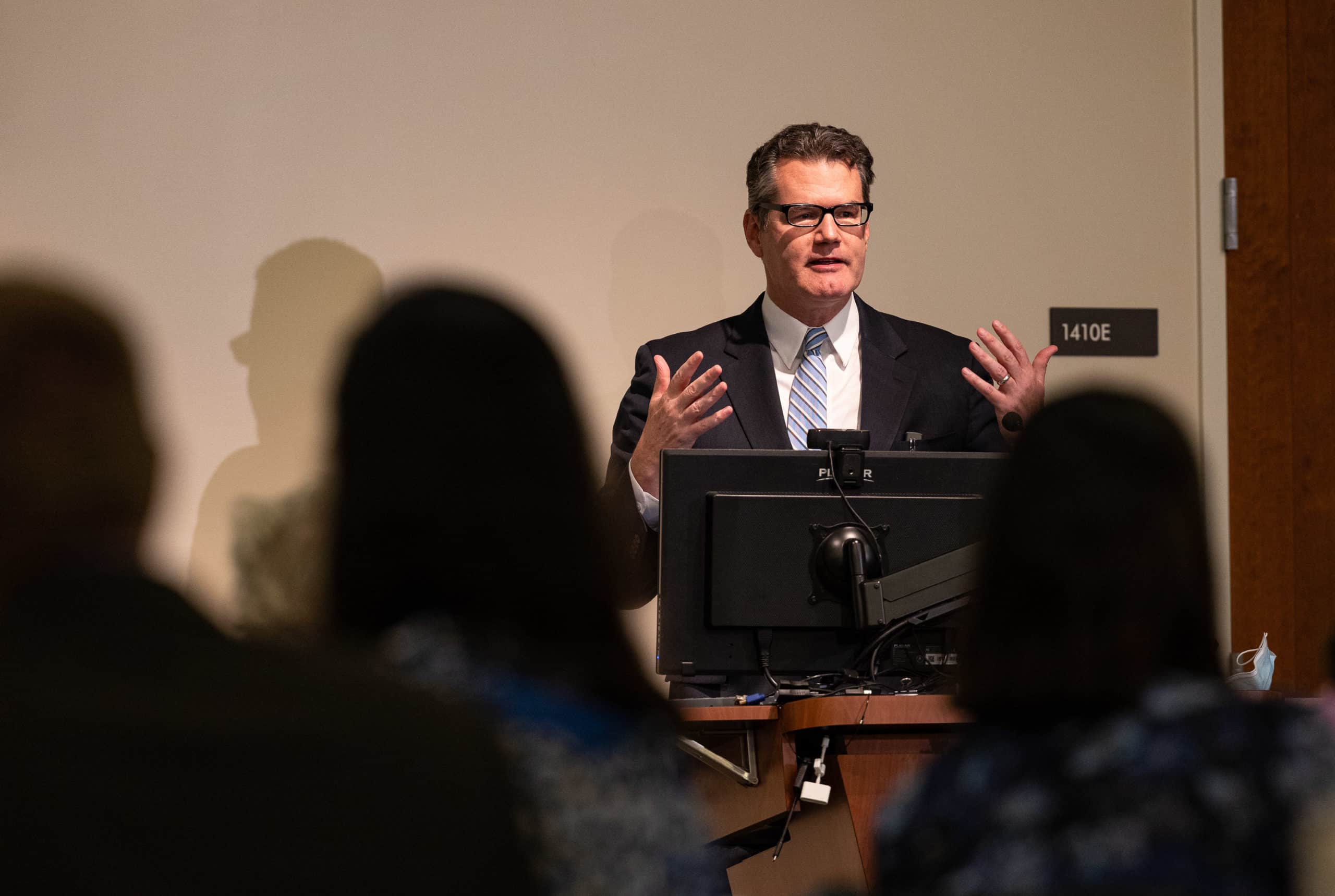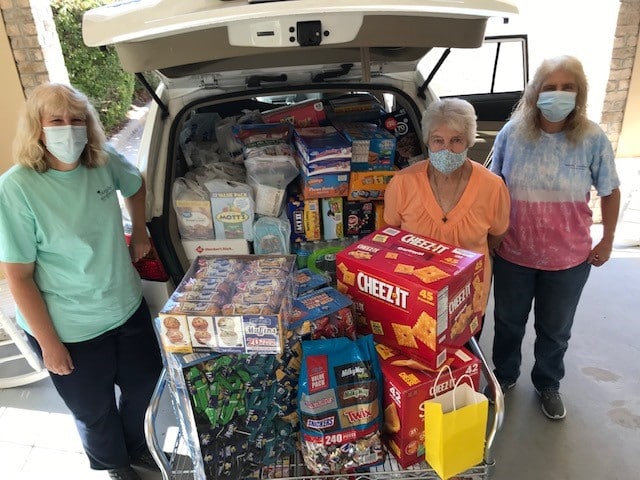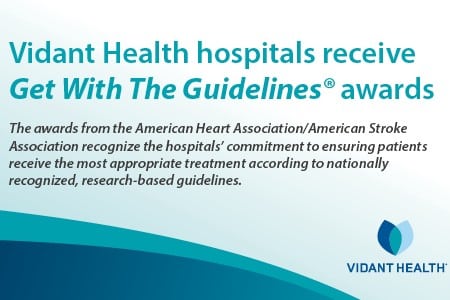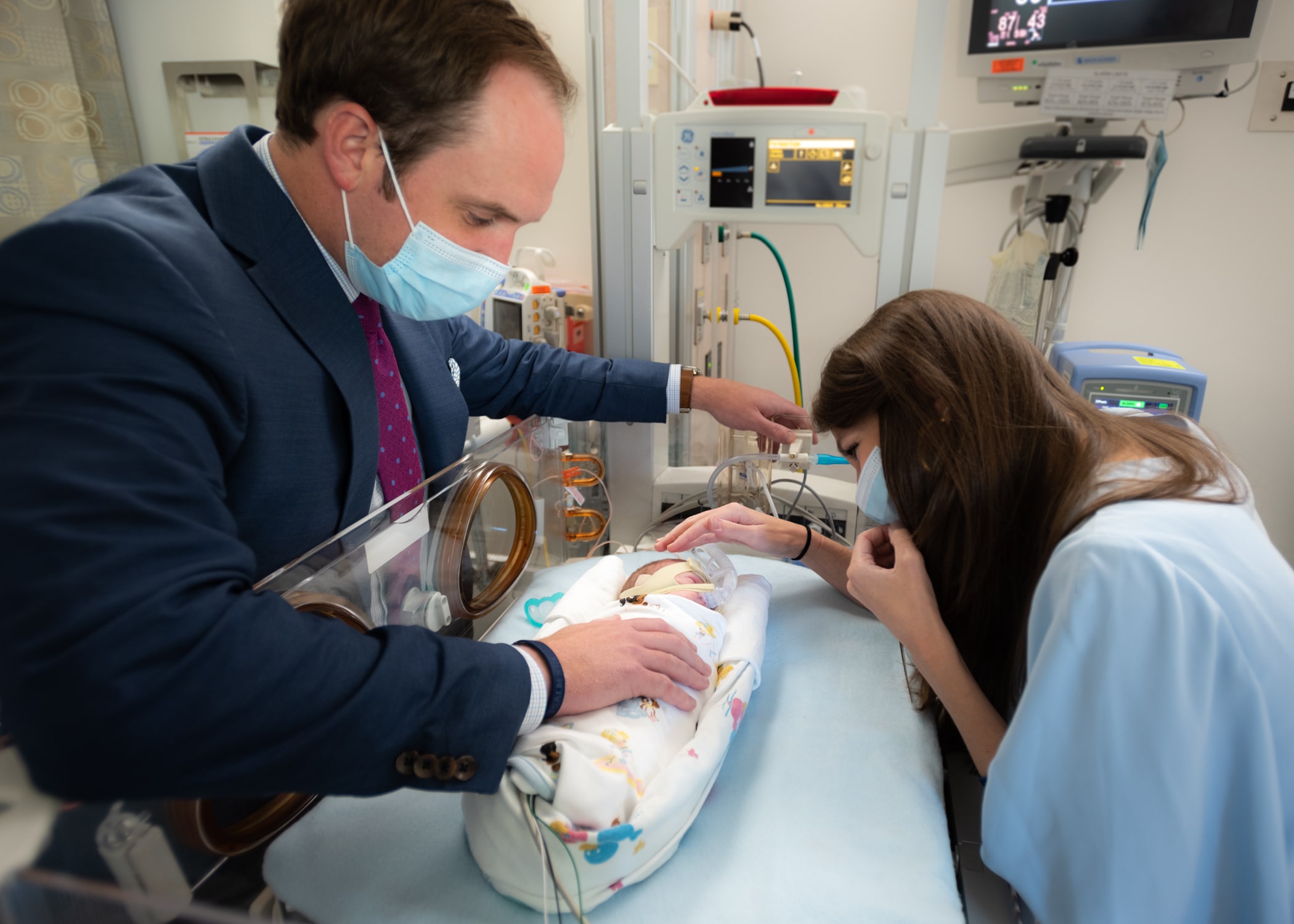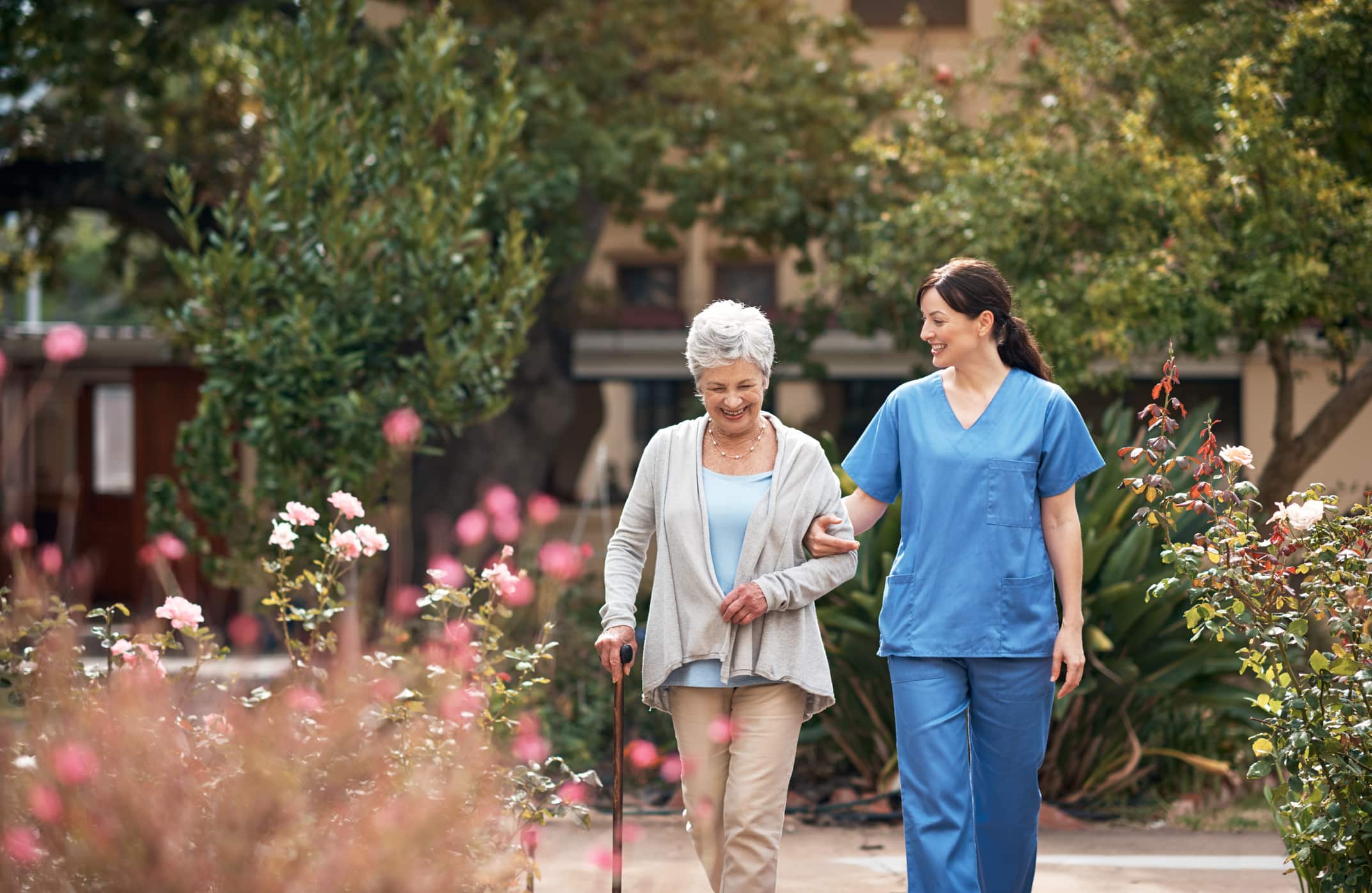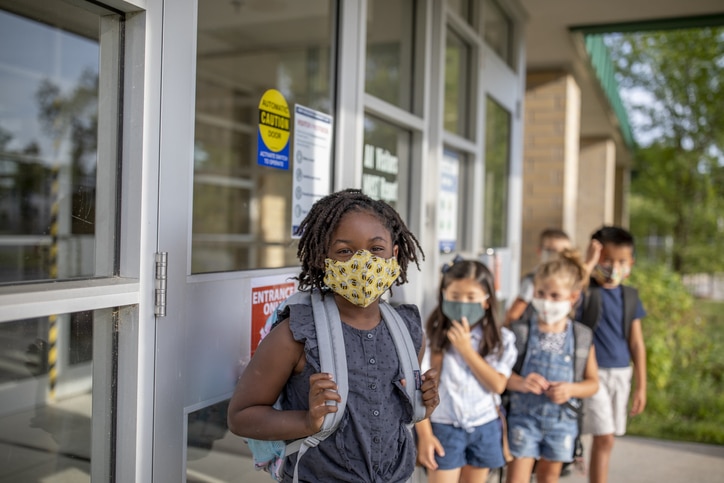October marks Breast Cancer Awareness Month and Vidant Health took the opportunity to promote the importance of early detection, recognize all the fighters and survivors, and honor those lost who lost their lives to the disease.
According to the National Breast Cancer Foundation, breast cancer is the most common cancer in American women, and it is estimated that in 2021, approximately 30 percent of all new cancer diagnoses in women will be breast cancer.
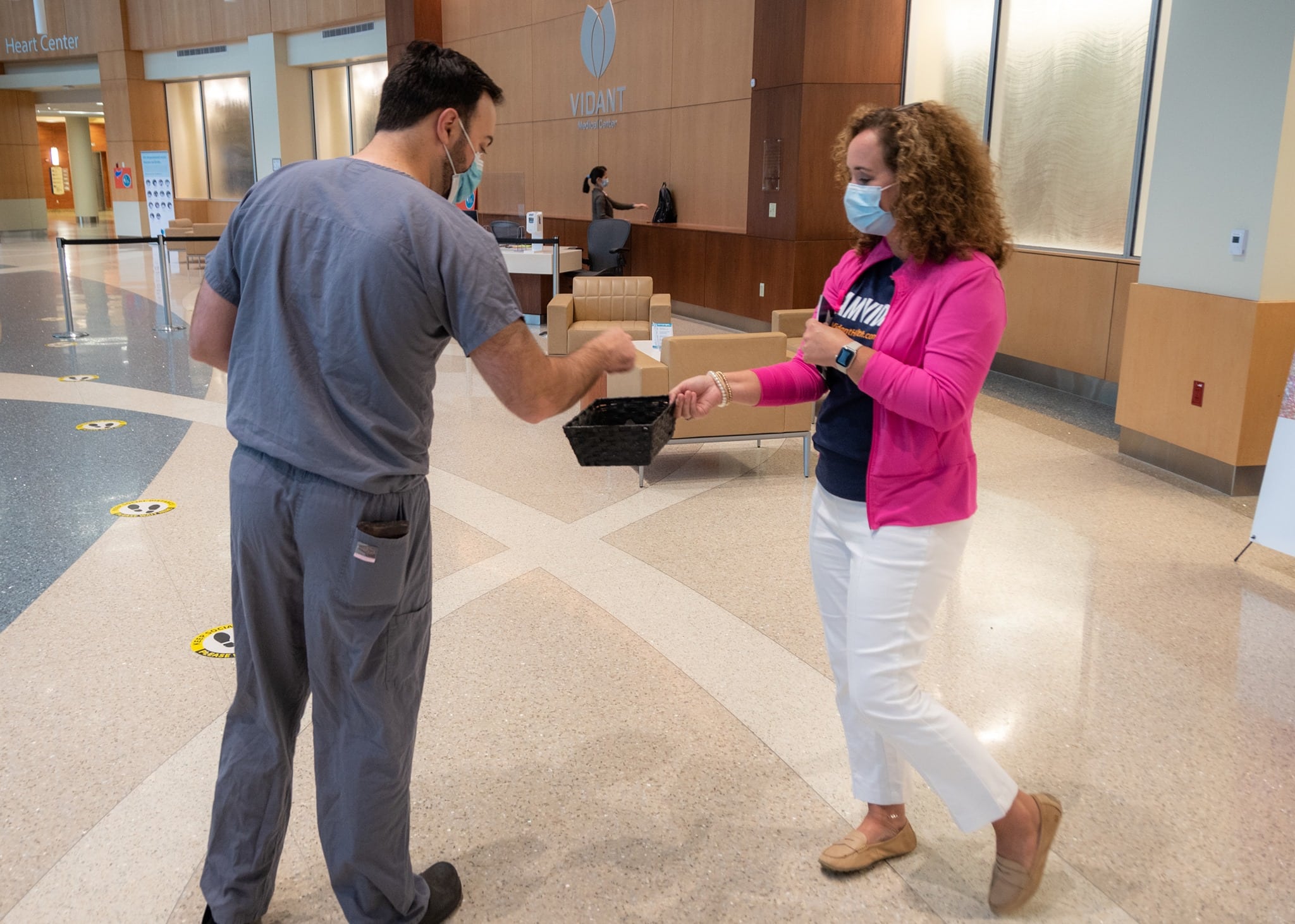
Early detection
Early detection is crucial and Vidant provides access to advanced screening tools like 3D mammography – the most advanced imaging tool available to detect breast cancer.
Dr. Mahvish Muzaffar, a medical oncologist at ECU Health Medical Center (VMC), sat down with WITN to discuss the importance of these screenings. According to the American Cancer Society, screenings have dropped significantly since the start of the COVID-19 pandemic.
Dr. Muzaffar said according to one study, there was a nearly 90 percent drop in breast and cervical cancer screenings. She said the drop was substantial in rural America and among ethnic minorities.
“We know that this may translate into an additional 10,000 lives lost, by conservative estimates, just because of that delay (in screenings),” Dr. Muzaffar said.
She said there are many safety measures in place to protect against COVID-19 when visiting doctors and getting regular cancer screenings.
Women between age 40 and 44 have the option to start screening with a mammogram every year. Women age 55 and older can switch to a mammogram every other year or they can choose to continue yearly screenings.
Visit Vidant’s Events page to see upcoming screening events throughout eastern North Carolina.
Know the risk factors
Knowing your risk factors for any illness or disease is crucial. Understanding what to look for if you are high risk can help save lives. Jennifer Lewis, outreach coordinator with ECU Health Cancer Care, said breast cancer is no different as she joined WITN to discuss risk factors.
“When you do have a first-degree relative which is a sister, mother or daughter, that does double your risk of developing breast cancer,” Lewis said.
Other risk factors include age, as the likelihood of developing breast cancers increases as you get older, alcohol consumption, smoking, weight and lifestyle, and hormone therapies after menopause.
While these steps are important in limiting your chances, the most important thing you can do is contact your primary care provider if you notice any changes.
Wear Pink Day
Each year, Vidant team members across the health system participate in Wear Pink Day to celebrate all breast cancer survivors and to show support and solidarity to those who are still in the fight.
The East Carolina University women’s basketball team showed their support by stopping by VMC to hand out pink ribbons to team members, patients and families at the Eddie and Jo Allison Smith Tower.
View photos from the event below.
To learn more about Vidant’s breast cancer services and connect with care teams, visit ECU Health Cancer Care’s web page.
Vidant Health team members and other community organizations came together to give patients at the James & Connie Maynard Children’s Hospital a Halloween experience to remember.
More than 20 cars drove by the Maynard Children’s Hospital with decorations on their cars and decked out in Halloween costumes. From the Mystery Machine to Star Wars and unicorns to super-dogs, everyone came out to put a smile on the face of Vidant’s smallest patients.
Alix Larrazabal is a Child Life student at the children’s hospital and helped organize the parade. She said the event was a success and seeing the reactions from the children was a highlight.
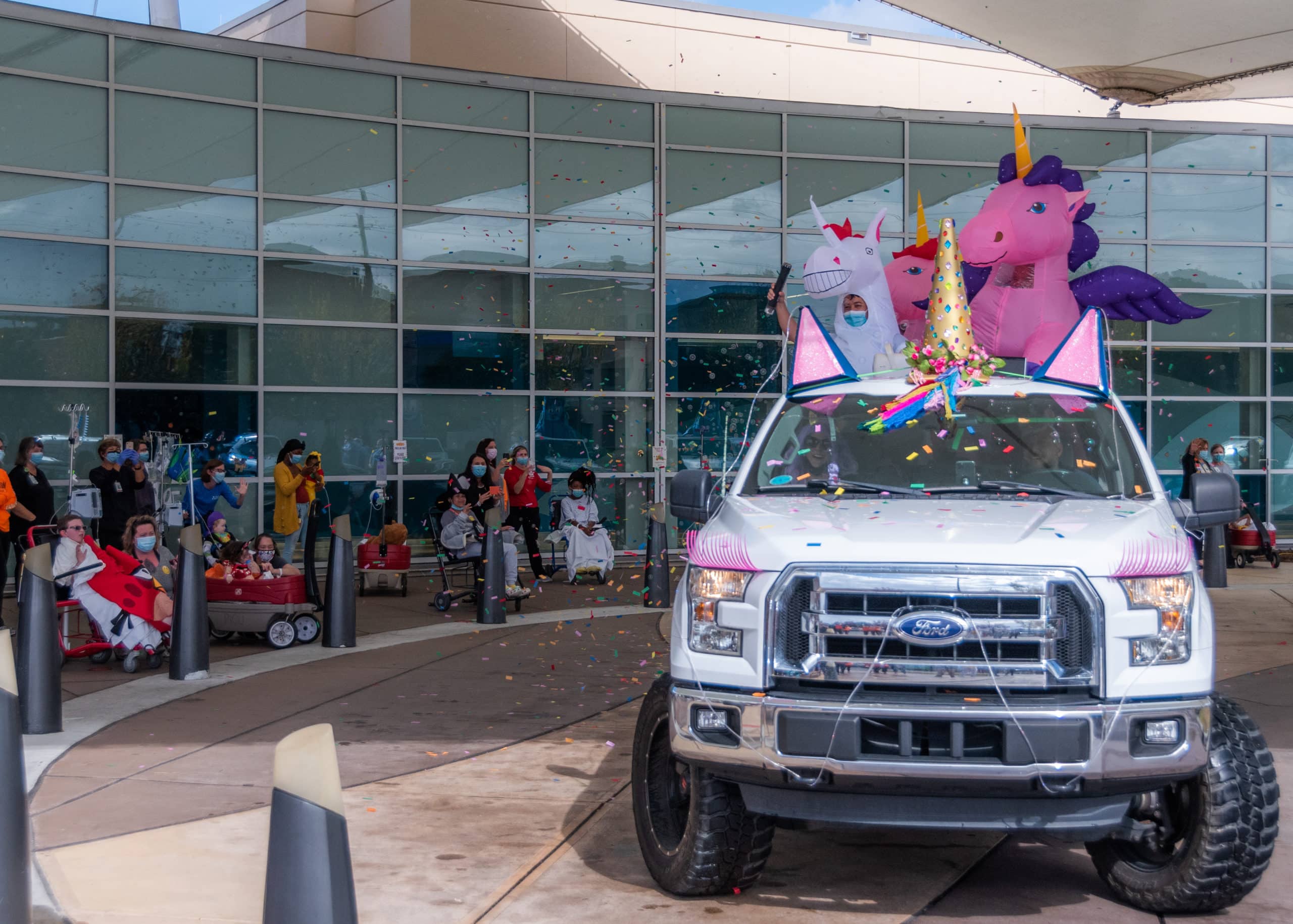
“It was honestly the most fun thing to see this come to life from the very beginning, months ago when we first started talking about it to seeing it now, how it turned out and how excited the kids were, it was amazing,” Larrazabal said. “I’m really happy with how it turned out.”
The ground outside the front entrance to the children’s hospital was decorated with Halloween-themed chalk as some East Carolina University students and children’s hospital patients brought out the spirit of the season. Many children showed off their Halloween costumes during the parade as well.
In years past, team members would dress up in their costumes and visit patients but COVID-19 brought about changes to the event. Last year was the first year of the parade-style Halloween celebration and it was a hit. Larrazabal said it’s important for the patients to have a safe and memorable holiday.
“This allows all the kids to safely come outside despite why they’re here at the hospital,” Larrazabal said. “It gives them a normal Halloween when they might not have gotten that inside the hospital.”
Larrazabal said the patients in the Maynard Children’s Hospital received a goodie bag with toys and art supplies as part of the event, whether or not they could make it outside to the parade.
Over the last seven years, Vidant Medical Center (VMC) has partnered with organizations across eastern North Carolina to host Project SEARCH for exceptional Pitt County students.
Project SEARCH is an international transition program that provides real life work experiences to high school graduates with intellectual and developmental disabilities. The one-year program helps students learn various marketable skills that can help them gain employment after graduation from the program.
Lisa Lassiter, director of workforce development at Vidant Health, said Pitt County Schools approached Vidant about the possibility of partnering in the program. She took the lead on the Vidant side and attended meetings, worked with community partners and, with support and approval from senior leaders at the hospital, had a classroom for these students created at VMC.
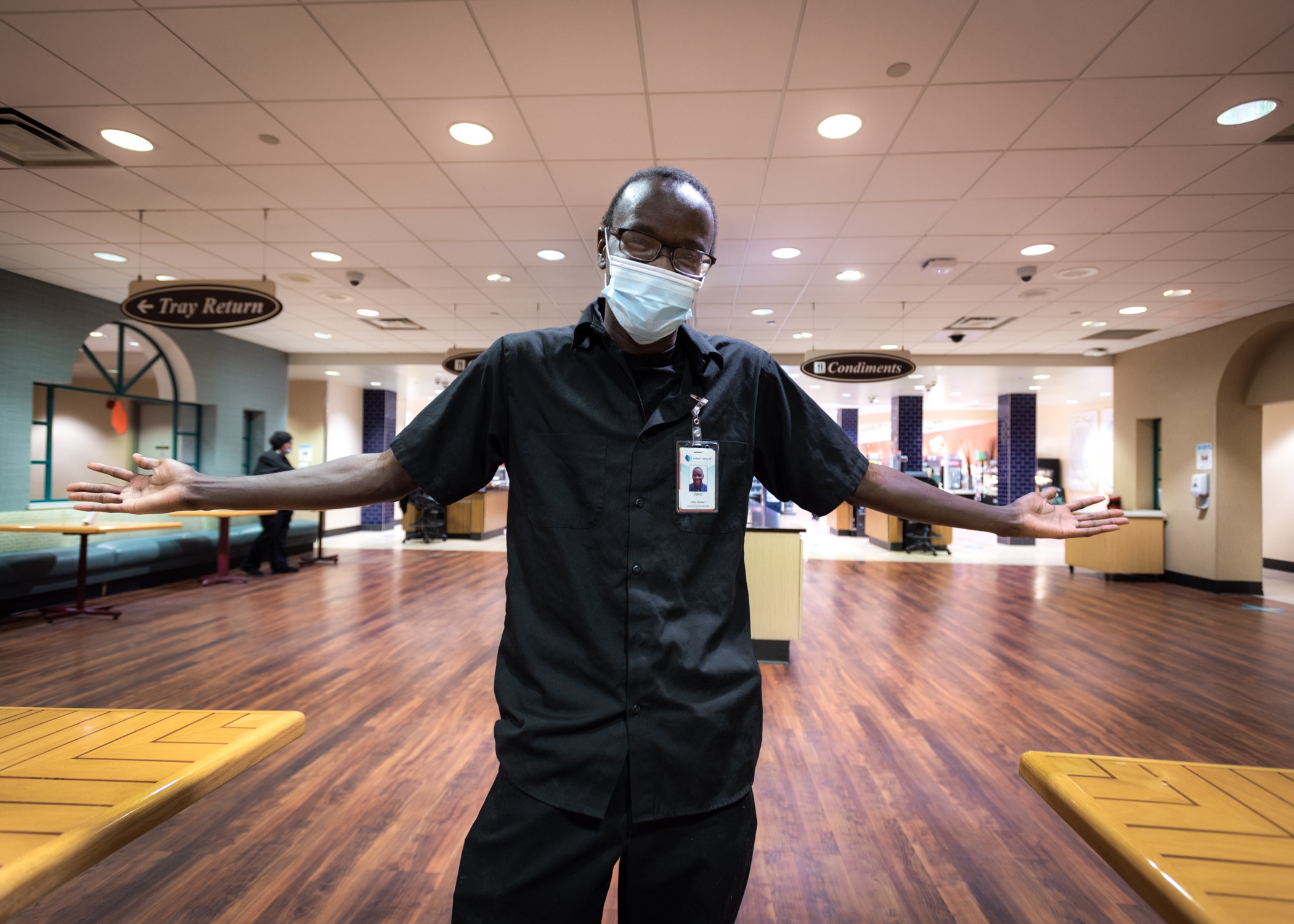
Lassiter said she is grateful for the program, the students, community partners and everyone involved.
“I think this program and these kids have taught me more than I have ever been able to expose to each of them,” Lassiter said. “I was very limited in what I knew about exceptional children when the program began and they have opened my eyes and amazed me many times.”
Seven years in, the 2021-22 Project SEARCH class is the largest to date with nine students. These students spend time in the classroom learning employable skills and go out to internship sites throughout different departments at VMC to practice and refine these skills.
A Shining Example
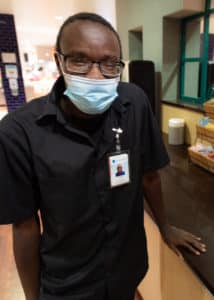 For students that have an internship experience at the VMC cafeteria, they get a chance to work with a program graduate.
For students that have an internship experience at the VMC cafeteria, they get a chance to work with a program graduate.
David Jenkins is a utility worker and is a direct supervisor for the Project SEARCH interns placed in the main cafeteria. Jenkins graduated from the program in 2019 and said he loves helping those going through their internships.
“I enjoy that a lot. I get to teach them about stuff that I know and I can sit back and watch them grow because of things that they learn from me,” Jenkins said. “Hopefully that will help them be a better citizen in this community.”
Jenkins had opportunities to intern in different areas throughout VMC during his year with Project SEARCH but enjoyed working in the cafeteria most. He said he felt a breakthrough when he asked to join team meetings during his internship and learned a lot about team goals.
He said it was important for him to go through the program and learn the important skills that have set him up for success today.
“My favorite part of going through the program was pretty much experiencing stuff that would be like the real world, such as advocating for myself, learning how to manage money, working with other people and how to interact with other people,” Jenkins said.
Katie Nagler Houmard, Project SEARCH instructor, said she was proud to see Jenkins’ growth from his time as a shy student to the leader he is today. She also said it’s important for current students to see what they can accomplish with Jenkins setting the example.
“We’ve seen that when they hear it from someone who has been where they are, they’re much more likely to really grasp it and take the advice,” Houmard said. “Sometimes when we tell them something, they could think, ‘What do you know? You’ve never been in my shoes.’ I think it’s inspiring for our current students to see him now in his role and working as part of the team at Vidant. It definitely gives them a good goal to work toward.”
Quintequa Weaver, Project SEARCH job coach, agrees. “I think just seeing him be a role model to the kids now is such a great thing to see,” she said.
It Takes a Village
Lassiter said community partnerships are an important part of what makes the program so special. While VMC hosts the classroom and offers the locations for internships, other community organizations contribute so much.
Pitt County Schools provide a teacher and identify students who make great candidates. RHA Health Services offers up a job coach to help students learn skills and work with them to find positions after graduation. On a state level, the North Carolina Council on Developmental Disabilities and North Carolina Vocational Rehabilitation provide support as well.
Internally to Vidant, team members who support the program are invaluable. Bernard Dixon, assistant manager for Central Services at VMC, is one of many team members who supports Project SEARCH and students going through the program. He said he appreciates the opportunity to work with these exceptional students and help them grow as team members.
When a student is preparing for an internship, they go through the typical steps that any team member would take before joining a department.
“They come down and they interview for the position as a typical employee would and we sit down and talk with them,” Dixon said. “Once we sit down and talk, we find out what exactly they can do and what their skill level is. Once we determine what their skill level is, we treat them just like we would any other employee.”
He has found that as he works with the students in Project SEARCH, once they are comfortable in their role, they often exceed expectations. He said supporting the students—and not putting labels or limitations on them while also helping them learn employable skills—is the most important thing his team can do.
“We don’t want them to be labeled or anything like that,” Dixon said. “It’s not about saying they can’t do this or they can’t do that – no. Let them do what they do. We find out that a lot of them can do more than we think they can.”
Learn more
- For more information on Project SEARCH, contact Lisa Lassiter via email at [email protected]
- Vidant Health News: Project SEARCH
- Project Search at ECU Health Medical Center 2021 Graduates
Greenville, N.C. – October 27, 2021 – ECU Health Medical Center (VMC) is proud to announce it has received re-certification for its cardiac and pulmonary rehabilitation program by the American Association of Cardiovascular and Pulmonary Rehabilitation (AACVPR). This is the fourth recertification for VMC by the AACVPR since 2012, and it recognizes VMC’s commitment to improving the quality of life of patients by enhancing standards of care.
To earn this certification, VMC’s cardiovascular and pulmonary rehabilitation program participated in an application process that required extensive documentation of the program’s practices. Each program’s application is reviewed by the AACVPR Program Certification Committee, and certification is awarded by the AACVPR Board of Directors.

For VMC, part of the application process included the submission of individual treatment plans that were evaluated for personalizing the care of patients and documenting patients’ rehabilitation for improvements in health.
“This outcome-based process with performance measurements shows more meaningful results in how we are making a positive impact on the lives of our patients,” said Stacey Greenway, director of cardiovascular disease management programs at VMC.
For patients in the cardiac and pulmonary rehabilitation program, it is the compassion of the staff that is a big part of their success. During rehabilitation, cardiac and pulmonary team members focus on the things the patients can control in order to improve their health and get them back to their daily activities. When patients take part in these rehabilitation programs, there is a 58 percent risk reduction of having a future cardiac or pulmonary episode.
“One of the most important benefits to patients participating in our cardiac and pulmonary rehabilitation program is learning how to become more engaged partners with their health care team,” Dr. Noel Peterson, cardiologist at Vidant Health, said. “We are pleased to once again receive this recognition of continued excellence in comprehensive care for our patients receiving cardiac and pulmonary rehabilitation.”
Cardiac rehabilitation is a combination of medical care and counseling to improve cardiovascular health after a heart attack, heart failure, angioplasty or heart surgery has taken place. It may include exercise counseling and training, lifestyle education (e.g., nutrition and reducing risk factors) and efforts to manage stress. Cardiac rehabilitation eases patients into heart-healthy exercises, nutrition education and education on how to manage risk factors such as stress.
Pulmonary rehabilitation can help reduce and control breathing difficulties and other symptoms of lung disease and benefit conditions including chronic obstructive pulmonary disease (COPD), emphysema, pulmonary hypertension and sarcoidosis. Pulmonary rehabilitation includes education and exercise to manage chronic lung disease with less shortness of breath.
“Factors like learning how to be more proactive about health and providing programs that demonstrate the highest standards of best practices makes a significant impact on the lives of our patients,” said Greenway. “The diligent work of our VMC cardiac and pulmonary rehabilitation team members recognized by the AACVPR is another example of how we are providing quality health care to improve the health and well-being of eastern North Carolina.”
Burnout in health care providers is not a new concept but ideas and theories of how to avoid it are developing in unique ways.
Dr. Stephen Trzeciak served as the featured lecturer for the 13th annual José G. Albernaz Golden Apple Distinguished Lecture presented by ECU Medical & Health Sciences Foundation and Vidant Health. Dr. Trzeciak, chief of medicine at Cooper University Health Care and professor and chair of medicine at Cooper Medical School of Rowan University in Camden, New Jersey, discussed compassion and the importance of meaningful connections in health care and everyday life.
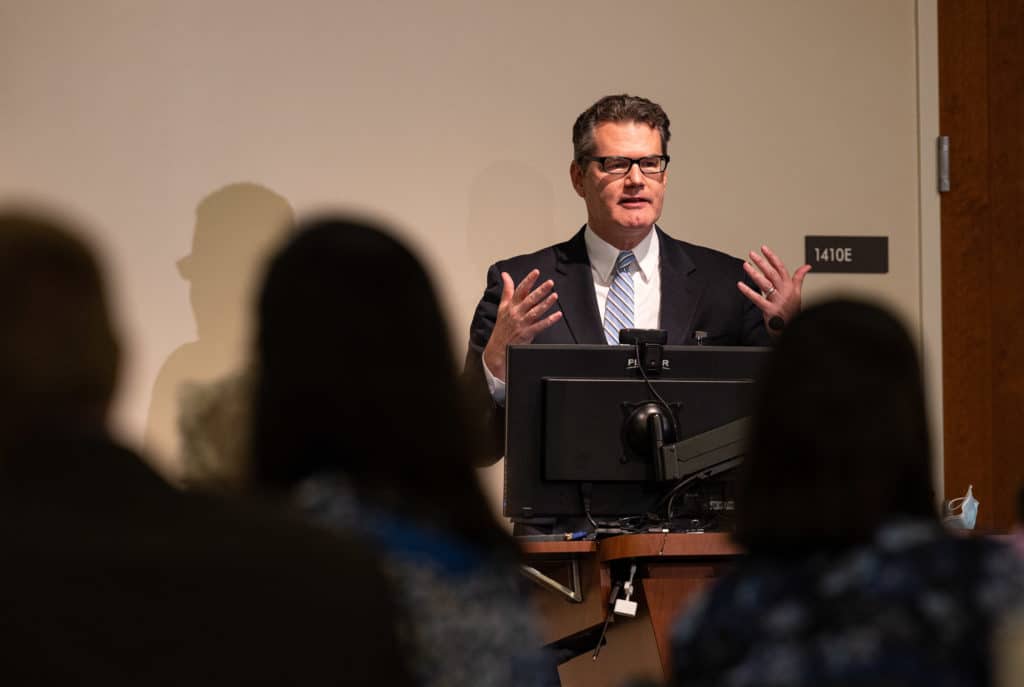
A few years ago, Dr. Trzeciak was facing burnout as a health care provider and knew something needed to change.
As a person who loves research, he began to dig into related literature and studies that focused on combating burnout in providers. In medical school, he said, he was taught that caring too much and having too much compassion could cause a provider burnout more quickly. What he found in studies, however, painted a different picture.
“What the literature shows is that there is an association with compassion and burnout – but it’s inverse. If there’s high compassion, there’s low burnout. Why? Well, we don’t know for sure but I have my hypothesis,” Dr. Trzeciak said. “Because when you connect with people through compassion, and have a relationship that flows from that, you get the fulfilling part. If you don’t have that then all you have is a really stressful job.”
Key to Resilience is Relationships
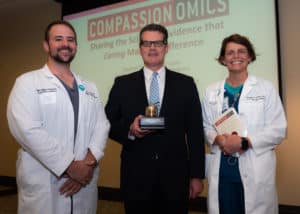
He tested his hypothesis on himself, as a study subject of one and found that when he leaned into caring more rather than detaching, his feelings of burnout began to lift. It wasn’t just about connecting with and showing compassion to patients and families, but to everyone he worked with and interacted with—professionally and personally. He believes this method can work not only within health care but in every walk of life.
He challenged everyone who is feeling the effects of burnout to give his method a chance, not just because it has worked for him and helped change his life, but because it is backed by science.
He highlighted a Harvard University study that tracked students at the university and Boston-area teenagers throughout their lives and found the best predictor of good health and well-being into your 80’s is your midlife quality of relationships. Dr. Trzeciak said this and many other studies show that the key to resilience is relationships.
“That’s why it is vitally important in our health systems, in our medical schools, everywhere – at the shopping mall, at the grocery store – that we take good care of each other,” Dr. Trzeciak said. “You don’t have to be a health care provider to feel burnout, especially in 2021.”
Compassion in Health Care
Compassionate and caring environments not only help team members face less burnout, but also help patients see better outcomes.
During his lecture, Dr. Trzeciak discussed many studies pointing to positive results for patients whose health care providers show compassion in various ways. He said that he does not have any magical thinking about compassion and that the top determinant of clinical outcome is still clinical excellence.
However, he said no patient and no provider should have to choose between clinical excellence and compassionate care. It’s not an either-or choice, but a both-and.
In eastern North Carolina
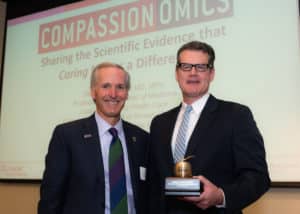 Dr. Michael Waldrum, chief executive officer of Vidant and dean of the Brody School of Medicine, said it was no mistake that Vidant chose compassion as one of its core values six years ago—a thoughtful selection rooted in understanding what behaviors help patients, the communities Vidant serves and team members.
Dr. Michael Waldrum, chief executive officer of Vidant and dean of the Brody School of Medicine, said it was no mistake that Vidant chose compassion as one of its core values six years ago—a thoughtful selection rooted in understanding what behaviors help patients, the communities Vidant serves and team members.
“As I think about that time and the now the world we live in today, with the most profound social and health care disruptions, with more Americans that died in any event in over 102 years… at no time is compassion more important than right now,” Dr. Waldrum said. “That is a really hard thing to deal with, those realities. The great thing is that we know we have solutions to the challenges we face and compassion is one of those solutions.”
Typically, the José G. Albernaz Golden Apple Distinguished Lecture is set for the first day of class for first-year Brody School of Medicine students. However, due to the COVID-19 pandemic, the event was held for a smaller audience with a few representatives from the first-year Brody class.
Dr. Waldrum said during the event that he recently had dinner with a group of first-year Brody students who discussed the need to bring greater compassion to health care.
“It was so impactful to me because I left that meeting last night and I’m just so proud to be in eastern North Carolina and having that dialogue and making compassion cool,” Dr. Waldrum said. “Because I think that’s what it takes. It takes intention in talking about it, understanding it and knowing we’ll never be perfect, but we’re all on this journey.”
“This is a place that feels like home, where families can come and spend meaningful time with a loved one,” said Jefferson. “The staff helped prepare our family for what we needed to know and expect. We met the chaplain and several team members while my father was at Inpatient Hospice House and the team members were so giving and welcoming to our family.”
“My father, Henry Edward Jefferson, was a father of eight children, so we had a large family to consider while visiting at Inpatient Hospice House,” said Jefferson. “Each family member was given one-on-one time to visit with my dad, and we were even able to bring our pets and the grandchildren for visits.”
Jefferson’s family received so much support from the staff at Inpatient Hospice House, they decided to provide support to other families experiencing similar circumstances there.
For the last 5 years, around the date of her father’s death, the Jefferson family has donated a carload of items for comfort and convenience, including snacks, prepackaged meals, cereal bars and treats to families of patients at Inpatient Hospice House.
“These food items allow people to stay here and visit loved ones without having to go out to get something to eat,” said Jefferson. “Families don’t want to miss a single precious moment with their loved one and these donations help allow more time together to enjoy each other’s company.”
For Jefferson and her family this annual delivery honors their father for the person he was and how much he gave to others in need. “This is our way of saying thanks for being here to help families going through this end of life experience and providing a sense of home.”
 Greenville, N.C. – October 11, 2021– Vidant Health hospitals have received several American Heart Association/American Stroke Association Get With The Guidelines® achievement awards for their work in treating stroke, diabetes, cardiac arrest, heart attack, and heart failure.
Greenville, N.C. – October 11, 2021– Vidant Health hospitals have received several American Heart Association/American Stroke Association Get With The Guidelines® achievement awards for their work in treating stroke, diabetes, cardiac arrest, heart attack, and heart failure.
These awards recognize the hospital’s commitment to ensuring patients receive the most appropriate treatment according to nationally recognized, research-based guidelines based on the latest scientific evidence.
“Vidant’s recognition by Get With The Guidelines® demonstrates our commitment to quality care. Meeting our mission to improve the health and well-being of eastern North Carolina means finding solutions for chronic conditions that affect so many in our region, “ said Teresa Anderson, PhD, RN, NE-BC, senior vice president of quality at Vidant. “The Vidant system is proud to be recognized by the American Heart Association for turning guidelines into lifelines.”
Vidant Health hospitals receiving recognition include:
Vidant Beaufort Hospital, a campus of ECU Health Medical Center — Stroke Gold Plus and Target Type 2 Diabetes Honor Roll
Vidant Chowan Hospital — Stroke Gold Plus and Target Type 2 Diabetes Honor Roll
Vidant Duplin Hospital — Stroke Silver Plus and Target Type 2 Diabetes Honor Roll
Vidant Edgecombe Hospital — Stroke Gold Plus and Target Type 2 Diabetes Honor Roll
ECU Health Medical Center — Stroke Gold Plus and Target Stroke Elite Plus Honor Roll, Target Type 2 Diabetes Honor Roll, Mission: Lifeline Award: Gold Receiving, and Mission: Lifeline NSTEMI: Gold
Vidant North Hospital — Stroke Silver Plus and Target Type 2 Diabetes Honor Roll
Vidant Roanoke-Chowan Hospital — Stroke Gold Plus, Target Stroke Honor Roll and Target Type 2, and Diabetes Honor Roll
The Outer Banks Hospital — Stroke Gold Plus and Target Stroke Honor Roll Elite
“We are pleased to recognize Vidant Health for their commitment to diabetes, stroke and heart care,” said Lee H. Schwamm, M.D., national chairperson of the American Heart Association’s Quality Oversight Committee and executive vice chair of neurology, director of Acute Stroke Services, Massachusetts General Hospital, Boston, Massachusetts. “Research has shown that hospitals adhering to clinical measures through the Get With The Guidelines® quality improvement initiative can often see fewer readmissions and lower mortality rates.”
Stroke, diabetes and cardiovascular disease, which includes heart failure, heart attack and cardiac arrest, are among the leading causes of death in the nation. Cardiovascular disease claims more lives each year than all forms of cancer and chronic lower respiratory disease combined.
According to the American Heart Association/American Stroke Association, stroke is the No. 5 cause of death and a leading cause of adult disability in the United States. On average, someone in the United States suffers a stroke every 40 seconds and there are nearly 795,000 new or recurrent strokes each year. Stroke kills about 140,000 Americans each year, accounting for one out of every twenty deaths. In eastern North Carolina, the stroke death rate is even higher, highlighting the need for preventative and rapid care.
“These awards are another proud moment for the Vidant Health system as it earns the recognition from AHA/ASA for providing the highest level of stroke care through its network of acute stroke ready hospitals, primary stroke centers and a comprehensive stroke center,” said Dr. Shailesh Male, stroke medical director at VMC. “This honor is a testament towards Vidant’s commitment to improve the health and well-being of eastern North Carolina.”
To speak with a Vidant neurologist for non-emergency care, please call 252-816-9700.
To find a heart and vascular provider, please visit Vidanthealth.com/Find-A-Doctor
On July 23, 2021, Cleere Reaves, 26 and a half weeks pregnant with her and her husband Will’s first child, headed to a regularly scheduled OB-GYN appointment with Dr. Kori Whitley for a glucose screening.
Cleere also had an ultrasound added to her visit, though it wasn’t totally necessary based on her scheduling.
“Praise God that was added,” Cleere said.
The ultrasound showed that something was wrong in the womb and it was time to move Cleere immediately over to Maynard Children’s Hospital at Vidant Medical Center. Dr. Whitley told Cleere and Will that they might be 90 hours from delivery, but their son would likely need to be delivered even earlier than that.
Will, a lawyer, began his nearly hour and a half drive from court in Onslow County while Cleere was admitted to the hospital for more ultrasounds and tests.
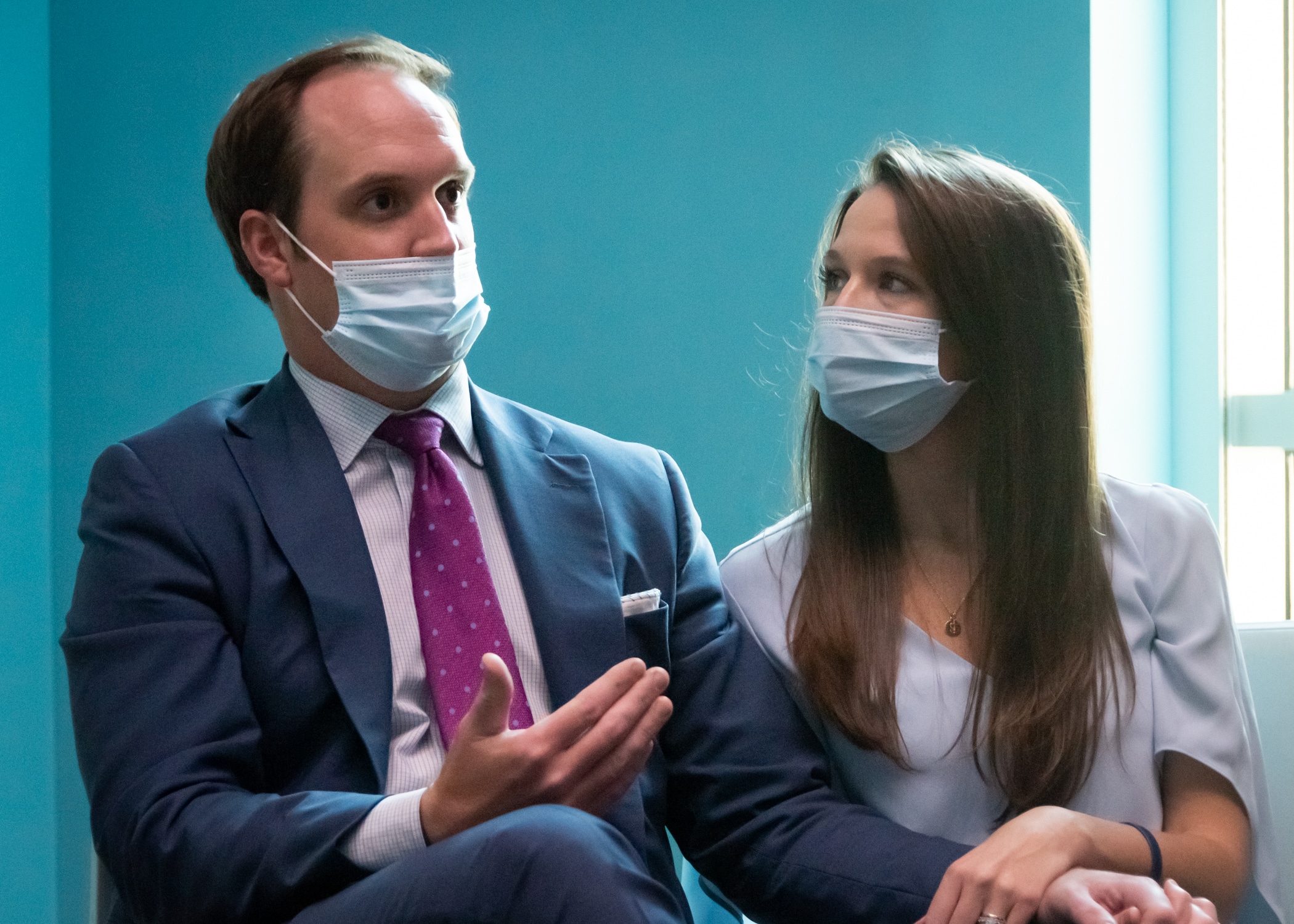
“Basically they figured out that they didn’t think it was safe for the baby to be in the womb anymore,” Will said. “And then the question was, well how long can he be in there?”
Sledge Strong
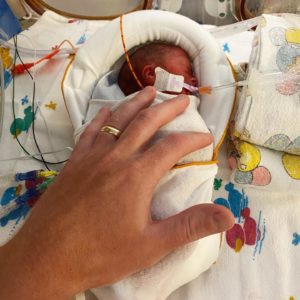
Photo courtesy of Reaves family
The time frame changed quickly as the team at Maynard Children’s Hospital reviewed the situation. Among several other factors, the ultrasound revealed that there was fluid around Sledge’s liver and near his brain, prompting doctors to be extremely concerned about a serious condition called hydrops, which can be life-threatening for premature babies.
Cleere was taken back about 2 p.m. that same day, July 23, to deliver her baby boy. As William Sledge Reaves was born, doctors could tell right away there was no sign of hydrops – the first big win in the life of a young fighter.
“It was really incredible because I can definitely tell you, there were angels in that room that helped him,” Cleere said. “I have no doubt that the Lord was very much present in that room and fighting for him.”
Sledge, with an appropriately tough name, weighed just 1 pound, 12 ounces at birth and was intubated right away to help him breathe. Intubating a child so small was another early win.
Sledge has been in the Neonatal Intensive Care Unit (NICU) at the Maynard Children’s Hospital since his birth and continues to get stronger and face the ups and downs of his young life.
Life in the NICU
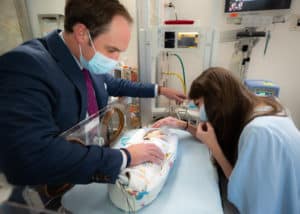
Cleere and Will said they often hear the term “NICU rollercoaster ride” as they navigate this time with their newborn son. There are plenty of wins and challenging times, but Will and Cleere both said the support of team members in the NICU keep them on track.
“The providers are really helpful with that,” Will said. “If Sledge does have a tough day with one thing, they’ll say look at all these other great things that happened today. It’s hard but it’s a great reminder.”
“You’re kind of trying to coach your mind to say ‘Hey, this is part of the ride and sometimes what feels like a back step is not. His body is learning, all his systems are growing, he’s maturing and this is part of it,'” Cleere said. “It’s really just having such a sense of trust that they’re good at what they do, this is not their first rodeo, so Will can be the dad and I can be the mom – because that’s what Sledge needs and he can feel that from us I think.”
Trusting the care team is an invaluable part of life in the NICU, Will and Cleere agreed. They said it’s not natural to have a baby and leave the hospital to go home with their child staying behind.
The camaraderie with the care team and welcoming team members at every turn who care for physical and emotional needs make it easier to sleep at night and come back into the Maynard Children’s Hospital each day to spend time with their baby boy and focus on being parents.
“I think it starts when you walk into the Children’s Hospital,” Will said. “Whether it’s Jackie, Barbra, Lee or anyone out there at the front desk who are just inviting and welcoming and asking how Sledge is doing. It starts there and then continues to when you get back and see Mr. Lawrence, Natasha or MJ and they’re asking how he’s doing, how you’re doing and making sure you have everything you need.
“Then, his primary care nurses, nurse practitioners, doctors – there are too many to name, there’s so many of them – they just make you feel like ‘Hey, we’re all here, we’re all in this together.’ That’s amazing when you consider the fact that every single one of them has been working 12-hour shifts. Whether you walk in at 7 a.m. or 7 p.m., you’re getting the same positive attitude.”
Moving Forward
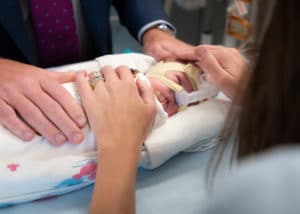 Cleere and Will said Sledge still has a long road ahead of him and they are proud of their son for all he has overcome to this point. Cleere has a mantra that she heard early on in their experience and keeps close to her heart through their time in the NICU.
Cleere and Will said Sledge still has a long road ahead of him and they are proud of their son for all he has overcome to this point. Cleere has a mantra that she heard early on in their experience and keeps close to her heart through their time in the NICU.
“As a mom, you just pray that he rests and grows and I think about that all the time,” Cleere said. “He’s going to have his bumps, we’ve had them and we’ll still have some. Then we’ll have it where we coast a little bit. But as he rests and as he grows, he’ll be able to handle and fight whatever comes his way and he’ll move right along.”
Sledge has come off of his ventilator but still receives some respiratory support. His feedings are growing and so is he as he was up to 4 pounds, 6 ounces at nine weeks.
The Reaves family looks forward to everyone being home together, but until then Sledge will continue to live up to his tough name and fight with parents and a care team by his side.
A fall is any unintentional coming to rest on the floor or ground and anyone can be at risk, especially older people. The negative health impacts of falls increase dramatically at or above the age of 80, when a substantial number of fractures and spinal cord injuries can occur.
Statewide, statistics show the unfortunate impact of falls on North Carolina residents. Sarah Taylor, marketing manager for Vidant Health Home & Hospice and co-chair of The Eastern NC Falls Coalition, said many members of our community may not realize how serious falls can be.
Falls are the second leading cause of unintentional injury death for North Carolinians of all ages, and in every year from 1999 to 2019 it was the number one cause of injury death for individuals 65 and older. According to the National Institute on Aging, ever year 30 percent of people over the age of 65 will sustain a fall, of which 10 percent will result in serious injury.
However, there is good news. Falls are preventable and there are several proactive steps community members can take to avoid falls and their impact.
“There are several classes of medications that can cause an increased risk of falls, and though they can have an effect on patients of all ages, they can especially impact seniors age 65 and older,” Conrad Kirby, adult nurse practitioner with Vidant Internal Medicine said.
It is important to talk to your provider about the medications you take and what side effects could impact your balance and awareness.
As risks of falls increase with age, there are recommended ways to avoid them. Make sure your home is as safe as possible and create an environment that is conducive for your daily household activities. Some of the recommended steps to creating a safer home include the following:
- Have adequate lighting at night (nightlight in bathrooms)
- Have handrails/grab bars in bathrooms
- Clear pathways
- Maintain proper footwear
- Remove loose rugs
- Account for proper toilet seat height
“Pets are part of the family, but in terms of falls, pets can also be a danger to the safety of humans,” said Taylor. “It is crucial to keep them from getting entangled in your legs and causing a fall.”
According to the Center for Disease Control, it is estimated that more than 86,000 fall injuries are caused by pets. There are certain tasks you can perform that can protect both pets and the people who love them:
- Before hauling in groceries put your pet in a different room to eliminate trips and falls
- Leave a light on at night so pets can be seen when walking to the bathroom
- Teach the pet to sit when someone knocks or rings the doorbell.
- Purchase a reflective collar for the pet
- Discourage pets from lingering in the kitchen during meal preparation
- Teach the pet to stay at the top or bottom of the steps until everyone is off the stair case
“Keeping up with vision checks with your eye doctor is one of most important ways of staying ahead of potential falling risks,” Kirby said. “Also, regular physical activity, proper diet and avoidance of excessive alcohol use can help you stay safe and reduce your risk for injury.”
Glen Newman, a physical therapist for Vidant Health added, “Preventative measures like exercise can help strengthen the body. Certain exercises which help build strength and balance can help you avoid falls.”
It is recommended to do some strengthening exercises as least twice a week to maintain independence and coordination.
For more information about resources regarding falls prevention visit https://ncfallsprevention.org/ and to learn more about exercise and wellness services, visit https://www.ecuhealth.org/services/wellness-prevention/
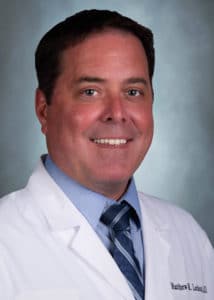
Dr. Matthew Ledoux
As a pediatrician serving eastern North Carolina, as well as a father to school-aged children, I truly appreciate the important role that in-person education has on the health and well-being of students. Schools are where children make lasting friendships, learn important social skills and receive a high-quality education that prepares them for life.
As we learned from the last school year, the only way we can keep our students in the classroom is to keep COVID-19 out of schools. That responsibility ultimately lies with parents and adults. With the Delta variant continuing to spread, even among children, we must do all we can to protect students by getting vaccinated, wearing a mask and practicing the common-sense safety measures that protect us all.
The Delta variant, which infects and presents serious symptoms in children at much higher rates than the original strain, is predominant in our community. In fact, it accounts for almost 100 percent of new COVID-19 cases detected through Vidant and ECU’s joint lab.
To protect our children and keep them in the classroom, it is crucial for everyone to wear a mask, especially if indoors and close together. Wearing a mask not only protects yourself, but also those around you. When all children are wearing masks in schools, only the person who tests positive for COVID-19 needs to go home and quarantine. If they are not wearing masks, the entire classroom, including the teacher, must be out to quarantine. Simply put, masks help keep kids in the learning environment.
In addition to masks, there are other measures we can take as parents to keep our kids safe. If your child is sick, keep them home. Do a quick symptom screener every morning to make sure they do not have a fever or any symptoms of COVID-19. Make sure your children routinely wash their hands and know how to properly wear masks.
If your child is eligible for the vaccine, get them vaccinated. If you are eligible, get vaccinated. Vaccines for school-aged children are nothing new, and the COVID-19 vaccine should be part of that routine if your child is eligible. Let’s do all we can to protect our community, keep our students in the classroom and give our children the best chance to succeed in their education.
For information on vaccines, please visit VidantHealth.com/vaccinate.
